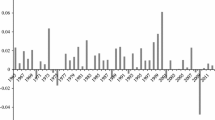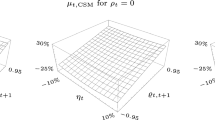Abstract
This paper seeks to examine the unidirectional versus bidirectional Granger causality between investors’ sentiment and momentum strategies. It is based on the full sample Granger causality test and the recent rolling-window bootstrap approach. We also applied a probit model to the extent to which the probability that investors’ sentiment and momentum strategies influence each other. Our results suggest bidirectional Granger causality between investor sentiment and momentum strategy with unstable causality dynamics over time. We find that ADS and VIX positively affect the likelihood that investor sentiment Granger causes momentum strategy and negatively impact the probability that momentum strategy Granger causes investor sentiment. Gold harms the likelihood that investors’ sentiment and momentum strategies affect each other. The research design is unique to combine bootstrap rolling-window Granger causality tests between Sentiment and Momentum to assess investors’ implications in terms of confidence, uncertainty, aggressiveness, or optimism versus Pessimism.

Similar content being viewed by others
Notes
The first group is based on market prices and includes the closed-end funds discount (CEFD), the put/call ratio, and the short-interest ratio. At the same time, the second group is derived from the polling of investors and encloses the University of Michigan Consumer Sentiment Index (CSI), the survey of the American Association of Individual Investors (AAII), and the Investors’ Intelligence index (II).
The macroeconomic indicators are real growth in durable consumption, growth in industrial production, growth in employment, services consumption, nondurable consumption, and National Bureau of Economic Research recession indicator.
References
Abid, I., Dhaoui, A., Goutte, S., Guesmi, K.: Hedging and diversification across commodity assets. Appl. Econ. 52(23), 2472–2492 (2020a)
Abid, I., Dhaoui, A., Guesmi, K., Kaabia, O.: Hedging strategy for financial variables and commodities. Econ. Bull. 40(2), 1368–1379 (2020b)
Andrews, D.W., Ploberger, W.: Optimal tests when a nuisance parameter is present only under the alternative. Econom. J. Econom. Soc. 62(6), 1383–1414 (1994)
Andrews, D.W.: Tests for parameter instability and structural change with unknown change point. Econom. J. Econom. Soc. 61(4), 821–856 (1993)
Antoniou, C., Doukas, J.A., Subrahmanyam, A.: Cognitive dissonance, sentiment, and momentum. J. Financ. Quant. Anal. 48(1), 245–275 (2013)
Baker, M., Wurgler, J.: Investor sentiment and the cross-section of stock returns. J. Financ. 61(4), 1645–1680 (2006)
Baker, M., Wurgler, J., Yuan, Y.: Global, local, and contagious investor sentiment. J. Financ. Econ. 104(2), 272–287 (2012)
Balcilar, M., Ozdemir, Z.A., Arslanturk, Y.: Economic growth and energy consumption causal nexus viewed through a bootstrap rolling window. Energy Econ. 32(6), 1398–1410 (2010)
Barberis, N., Shleifer, A., Vishny, R.: A model of investor sentiment. J. Financ. Econ. 49(3), 307–343 (1998)
Basher, S.A., Sadorsky, P.: Hedging emerging market stock prices with oil, Gold, VIX, and bonds: a comparison between DCC ADCC and GO-GARCH. Energy Econ. 54, 235–247 (2016)
Baur, D.G., Lucey, B.M.: Flights and contagion-an empirical analysis of stock-bond correlations. J. Financ. Stab. 5(4), 339–352 (2009)
Bottazzi, G., Dindo, P., Giachini, D.: Momentum and reversal in financial markets with persistent heterogeneity. Ann. Finance 15(4), 455–487 (2019)
Daniel, K., Hirshleifer, D., Subrahmanyam, A.: Investor psychology and security market under-and overreactions. J. Financ. 53(6), 1839–1885 (1998)
DeLong, J.B., Shleifer, A., Summers, L., Waldmann, R.: Noise trader risk in financial markets. J. Polit. Econ. 98, 703–738 (1990)
Dolado, J.J., Lütkepohl, H.: Making Wald tests work for cointegrated VAR systems. Economet. Rev. 15(4), 369–386 (1996)
Frazzini, A.: The disposition effect and underreaction to the news. J. Financ. 61(4), 2017–2046 (2006)
Friesen, G.C., Weller, P.A., Dunham, L.M.: Price trends and patterns in technical analysis: a theoretical and empirical examination. J. Bank. Finance 33(6), 1089–1100 (2009)
Griffin, J.M., Ji, X., Martin, J.S.: Momentum investing and business cycle risk: evidence from pole to pole. J. Financ. 58(6), 2515–2547 (2003)
Grinblatt, M., Han, B.: Prospect theory, mental accounting, and momentum. J. Financ. Econ. 78(2), 311–339 (2005)
Hacker, R.S., Hatemi-J, A.: Tests for causality between integrated variables using asymptotic and bootstrap distributions: theory and application. Appl. Econ. 38(13), 1489–1500 (2006)
Hameed, A., Kusnadi, Y.: Momentum strategies: evidence from Pacific Basin stock markets. J. Financ. Res. 25(3), 383–397 (2002)
Hameed, A., Yuanto, K.: Momentum strategies: evidence from the pacific basin stock markets. J. Financ. Res. 45, 383–398 (2002)
Hao, Y., Chu, H.H., Ko, K.C., Lin, L.: Momentum strategies and investor sentiment in the REIT market. Int. Rev. Financ. 16(1), 41–71 (2016)
Hao, Y., Chou, R.K., Ko, K.C., Yang, N.T.: The 52-week high, momentum, and investor sentiment. Int. Rev. Financ. Anal. 57, 167–183 (2018)
Hong, H., Stein, J.C.: A unified theory of underreaction, momentum trading, and overreaction in asset markets. J. Financ. 54(6), 2143–2184 (1999)
Jegadeesh, N., Titman, S.: Returns to buying winners and selling losers: implications for stock market efficiency. J. Financ. 48(1), 65–91 (1993)
Kim, B., Suh, S.: Sentiment-based momentum strategy. Int. Rev. Financ. Anal. 58, 52–68 (2018)
Lee, C.M., Shleifer, A., Thaler, R.H.: Investor sentiment and the closed-end fund puzzle. J. Financ. 46(1), 75–109 (1991)
Linden, A., Yarnold, P.R.: Identifying causal mechanisms in health care interventions using classification tree analysis. J. Eval. Clin. Pract. 24(2), 353–361 (2018)
Mantalos, P., Shukur, G.: Size and power of the error correction model cointegration test. A bootstrap approach. Oxf. Bull. Econ. Stat. 60(2), 249–255 (1998)
Mantalos, P.: A graphical investigation of the size and power of the Granger-causality tests in integrated-cointegrated VAR systems. Stud. Nonlinear Dyn. Econ. (2000). https://doi.org/10.2202/1558-3708.1053
Mosconi, R., Seri, R.: Non-causality in bivariate binary time series. J. Econ. 132(2), 379–407 (2006)
Moskowitz, T.J., Ooi, Y.H., Pedersen, L.H.: Time-series momentum. J. Financ. Econ. 104(2), 228–250 (2012)
Park, J.Y., Phillips, P.C.: Statistical inference in regressions with integrated processes: part 1. Economet. Theor. 4(3), 468–497 (1988)
Pesaran, M.H., Timmermann, A.: Small sample properties of forecasts from autoregressive models under structural breaks. J. Econom. 129(1–2), 183–217 (2005)
Rouwenhorst, K.G.: International momentum strategies. J. Financ. 53(1), 267–284 (1998)
Shahzad, S.J.H., Nor, S.M., Hammoudeh, S., Shahbaz, M.: Directional and bidirectional causality between U.S. industry credit and stock markets and their determinants. Int. Rev. Econom. Financ. 47, 46–61 (2017)
Shiller, R.J.: Measuring bubble expectations and investor confidence. J. Psychol. Financ. Markets 1(1), 49–60 (2000)
Shukur, G., Mantalos, P.: Tests for Granger causality in integrated-cointegrated VAR systems. Working paper 1998:1, Department of Statistics, University of Lund, Sweden (1997)
Shukur, G., Mantalos, P.: A simple investigation of the Granger-causality test in integrated-cointegrated VAR systems. J. Appl. Stat. 27(8), 1021–1031 (2000)
Shukur, G., Mantalos, P.: Size and power of the RESET test as applied to systems of equations: a bootstrap approach. J. Mod. Appl. Stat. Methods 3(2), 10 (2004)
Toda, H. Y., Phillips, P. C.: Vector autoregressions and causality. Econom. J. Econom. Soc. 1367–1393 (1993)
Toda, H.Y., Phillips, P.C.: Vector autoregression and causality: a theoretical overview and simulation study. Economet. Rev. 13(2), 259–285 (1994)
Toda, H.Y., Yamamoto, T.: Statistical inference in vector autoregressions with possibly integrated processes. J. Econom. 66(1–2), 225–250 (1995)
Funding
None.
Author information
Authors and Affiliations
Corresponding author
Ethics declarations
Conflict of interest
There is no conflict of interest.
Data availability
Data are available on request.
Code availability
Codes are available on request.
Ethics approval
The authors declare that this study is in consistence with the ethics of scientific research.
Consent for publication
The authors express their consent to participate in the paper and declare that they agree to publish this paper in the Annals of Finance.
Additional information
Publisher's Note
Springer Nature remains neutral with regard to jurisdictional claims in published maps and institutional affiliations.
Rights and permissions
About this article
Cite this article
Nakhli, M.S., Dhaoui, A. & Chevallier, J. Bootstrap rolling-window Granger causality dynamics between momentum and sentiment: implications for investors. Ann Finance 18, 267–283 (2022). https://doi.org/10.1007/s10436-021-00399-z
Received:
Accepted:
Published:
Issue Date:
DOI: https://doi.org/10.1007/s10436-021-00399-z




